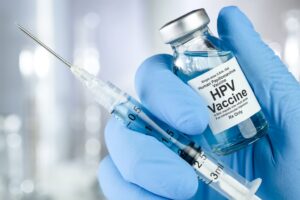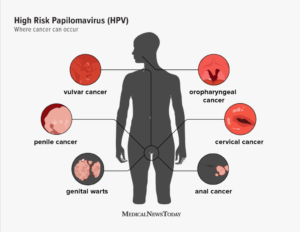The Truth Behind the HPV Vaccine

Marcela Barros
The City College of New York
Writing for the Sciences – ENG 21003
Instructor: Debra Williams
September 27, 2023
There are many infections in this world that show few to no symptoms. There are also many infections that can lead to various types of cancers. Did you know that this is the case for the most common sexually transmitted infection (STI) in the U.S?
Human papillomavirus (HPV) is the most common sexually transmitted infection (STI) in all of the U.S (CDC). Since it is a sexually transmitted infection (STI), a person can become infected with HPV through vaginal, anal, or oral sex with someone who has HPV. HPV does not usually come with any symptoms which is why it can be hard to detect by a person who has become infected with it. If symptoms are noticeable, then they are typically genital warts, genital itching or sore/cracked skin. On one hand, HPV typically goes away within 2 years. On the other hand, if it does not, it can lead to more serious things such as anal, cervical, oropharyngeal, penile and vulvar cancer.

Because medicine has evolved through time, the HPV vaccine exists. It can be taken to prevent the risk of getting HPV. This vaccine is typically administered in 2 doses, the second being given 6-12 months after the first dose was received. In the case that the second dose is given past this time, a third dose might be needed to preserve the strength of the vaccine. This vaccine is typically given to 11-12 year old males and females. It can be given to 9 year old males and females and is highly recommended to be given before 15 years old. This vaccine can be given until a person is 26 years old, any age past this point needs consultation with a doctor (CDC).
Like many things in science, the general public doesn’t seem to question how scientists got to their discovery. In this case, it should be questioned. Many people are unaware of how the HPV vaccine came to be and it was actually made possible by a woman named Henrietta Lacks. Henrietta Lacks was a black woman whose cells completely changed medicine. Her cells are unique because they are the first immortal cells that were discovered. This means that her cells are capable of growing and dividing again and again. These cells were taken from Henrietta Lacks without her permission and without her knowledge during a biopsy collected of her cancer cells by Doctor George Gey (Miller, G., DiMaio, D., Lockwood, C., & Rose, J ). Henrietta herself had cervical cancer, which was found to have HPV cells in. Because of this biopsy and collection of cells, scientists were able to find the connection between HPV to various cancers such as cervical cancer. They were also able to experiment and conduct trials using Hela cells to find a vaccine for HPV.
Because Henrietta Lacks was a Black woman and because she was deceived during her biopsy, institutionalized racism came into play. Institutionalized racism is discrimination towards a specific person because of their race and it occurs within a social institution, such as a hospital. This experience that came from Henrietta Lacks is just one of many instances of institutionalized racism/bias that can take place within science. Another instance where institutionalized racism occurred in a similar environment is during the Tuskegee Syphilis Study. In this study, multiple black men were unknowingly injected with syphilis so discoveries and advances could be made about the infection (CDC). In both cases, people of color were wrongfully misled and taken advantage of. Because of cases like these, there have been negative views created within the world of science for people of color. It has hurt the trust between the public so they become more cautious and worrisome when it comes to simple things such as check ups. To them, you never know who to trust.
Many more medical advances have been made thanks to HeLa cells. HeLa cells have been used to find various other vaccines such as the polio vaccine and even the COVID-19 vaccine. HeLa cells have also been used to study the effects of X-rays on human cells, drugs for cancer, determining how salmonella can cause infection, understanding HIV and many more advancements. It is important going forward, that she is acknowledged, creddited and thanked for her contributions to modern day science/medicine.
References
Image 1: Handley, E., & here, P. (2021, November 5). HPV immunisation programme reduces cervical cancer by 90%. Open Access Government. https://www.openaccessgovernment.org/hpv-immunisation-programme-cervical-cancer/123681/
Image 2: MediLexicon International. (n.d.). High risk HPV: Types, treatments, and more. Medical News Today. https://www.medicalnewstoday.com/articles/high-risk-hpv
Centers for Disease Control and Prevention. (2022, April 12). STD Facts – Human papillomavirus (HPV). Centers for Disease Control and Prevention. https://www.cdc.gov/std/hpv/stdfact-hpv.htm
Miller, G., DiMaio, D., Lockwood, C., & Rose, J. (2006). The virus behind the cancer. Yale School of Medicine. https://medicine.yale.edu/news/yale-medicine-magazine/article/the-virus-behind-the-cancer/
Centers for Disease Control and Prevention. (2021, November 16) HPV Vaccination Recommendations. Centers for Disease Control and Prevention. https://www.cdc.gov/vaccines/vpd/hpv/hcp/recommendations.html#:~:text=Three%20doses%20of%20HPV%20vaccine,1–2%20and%206%20months.
Centers for Disease Control and Prevention. (2022, December 5). Tuskegee Study – Timeline – cdc – os. Centers for Disease Control and Prevention. https://www.cdc.gov/tuskegee/timeline.htm#:~:text=Participants%27%20informed%20consent%20was%20not,free%20meals%2C%20and%20burial%20insurance.


